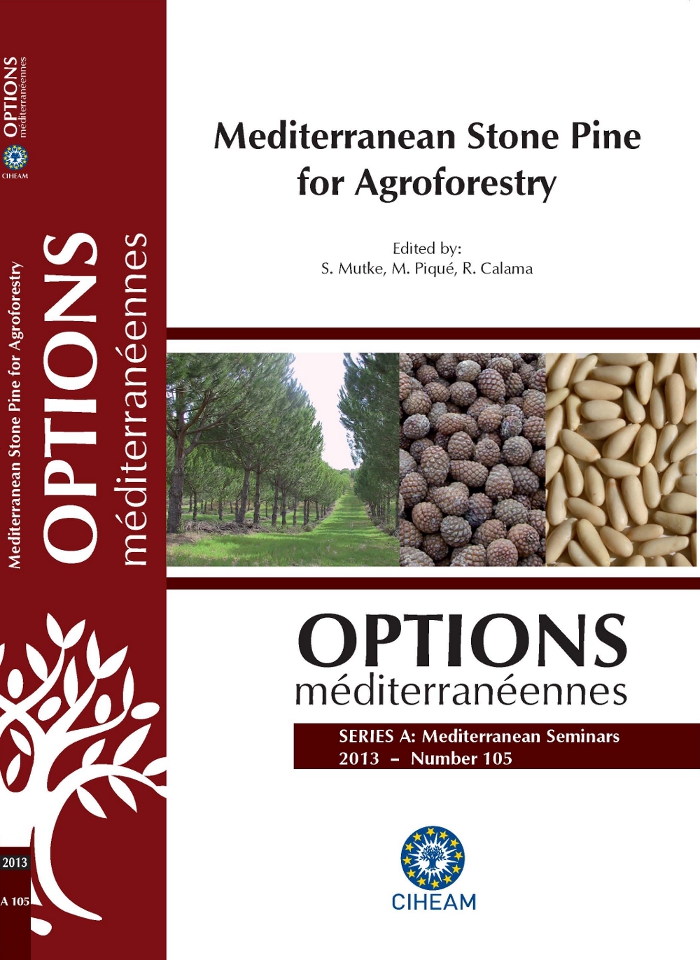| Article précédent | p. 99-104 | Article suivant |
Chemical profiling of Portuguese Pinus pinea L. nuts and comparative analysis with Pinus koraiensis Sieb. & Zucc. commercial kernels
Being an endemic species to the Mediterranean Basin, stone pine (Pinus pinea L.) obtains an extreme economical relevance in Spain, Portugal, Italy, Tunisia and Turkey, where pine nuts are traditionally marketed and consumed. Based on the analysis of 27 different Portuguese populations, pine nuts were characterized by high contents of fat (47.7 g per 100 g dry matter DM), protein (33.9 g per 100 g DM) and phosphorus (1130 mg per 100 g DM) and low contents of moisture (5.9 g per 100 g DM) and starch (3.5 g per 100 g DM). They were also found to be a good source of zinc, iron and manganese. A comparative analysis with P. koraiensis nuts showed the latter to have lower protein (14.1 g per 100 g DM) vitamin and mineral contents, and higher fat (68.1 g per 100 g DM) and pinolenic acid contents (14.5% vs 0.3% w/w TFA). Protein and pinolenic acid contents could be considered as good parameters to distinguish the edible kernels of these two species.
Le pin pignon (Pinus pinea L), espèce endémique au bassin méditerranéen, a un poids économique considérable dans quelques régions d’Espagne, du Portugal, d’Italie, de la Tunisie et de la Turquie où, traditionnellement, le pignon de pin est commercialisé et consommé. En se basant sur l'analyse de 27 populations portugaises différentes, le pignon de pin a été caractérisé par des teneurs élevées en graisse (47.7 g pour 100 g de matière sèche MS), en protéines (33.8 g pour 100 g MS) et en phosphore (1130 mg pour 100 g MS) et de faibles teneurs en humidité (5.9 g pour 100 g de MS) et en amidon (3.5 g pour 100g MS). De plus il s’est révélé être une bonne source de zinc, de fer et de manganèse. Une analyse comparative avec le pignon de P. koraiensis a montré que celui-ci a des teneurs en protéines (14.1 g MS pour 100 g) et en vitamines et minéraux plus faibles. Par contre, les teneurs en acides gras (68.1 g pour 100 g MS) et en acide pinolénique (14,5% vs 0,3% p/p du total en acides gras) sont plus élevées. Les teneurs en protéines et en acide pinolénique pourraient être considérées comme des paramètres à retenir pour différencier le pignon comestible de ces deux espèces.
- [ Afficher ]
- [ Télécharger ]
- [ Exporter la citation ]
Vous pouvez télécharger la citation au format :
- [ Imprimer ]
-
Mots-clés
ACIDE GRAS, AGROFORESTERIE, ANALYSE EN COMPOSANTES PRINCIPALES, COMPOSITION CHIMIQUE, PINUS PINEA, PORTUGAL, VALEUR NUTRITIVE, CONE, PINUS KORAIENSISCiter cet article
Evaristo I., Batista D., Correia I., Correia P., Costa R. Chemical profiling of Portuguese Pinus pinea L. nuts and comparative analysis with Pinus koraiensis Sieb. & Zucc. commercial kernels. In : Mutke S. (ed.), Piqué M. (ed.), Calama R. (ed.). Mediterranean stone pine for agroforestry. Zaragoza : CIHEAM / FAO / INIA / IRTA / CESEFOR / CTFC, 2013. p. 99-104. (Options Méditerranéennes : Série A. Séminaires Méditerranéens; n. 105). AGROPINE 2011 International Meeting on Mediterranean Stone Pine for Agroforestery, 2011/11/17-19, Valladolid (Spain). http://om.ciheam.org/om/pdf/a105/00006787.pdf



